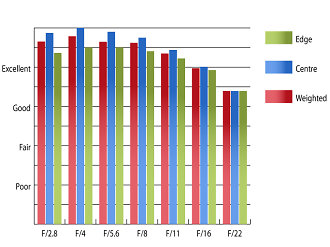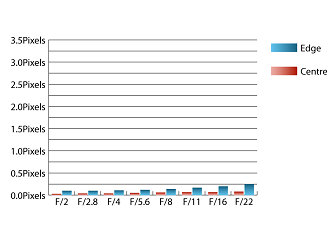Nikon AF-S NIKKOR 400mm f/2.8E FL ED VR Lens Review
Nikon AF-S NIKKOR 400mm f/2.8E FL ED VR Performance
During testing, this lens produced outstanding sharpness from maximum aperture, improving a little when stopped down to f/4.
How to read our charts
The blue column represents readings from the centre of the picture frame at the various apertures and the green is from the edges. Averaging them out gives the red weighted column.The scale on the left side is an indication of actual image resolution. The taller the column, the better the lens performance. Simple.
For this review, the lens was tested on a Nikon D600 using Imatest.
Levels of chromatic aberrations are virtually non-existent, which is quite incredible for a super-telephoto lens, only just reaching 0.5 pixel widths towards the edges of the frame when stopped down to f/22. This low level of fringing should be pretty much impossible to spot in normal image taking, even with areas of high contrast towards the edges of the frame.
How to read our charts
Chromatic aberration is the lens' inability to focus on the sensor or film all colours of visible light at the same point. Severe chromatic aberration gives a noticeable fringing or a halo effect around sharp edges within the picture. It can be cured in software.Apochromatic lenses have special lens elements (aspheric, extra-low dispersion etc) to minimize the problem, hence they usually cost more.
For this review, the lens was tested on a Nikon D600 using Imatest.
Falloff of illumination towards the corners is well controlled for a lens of this type. At f/2.8 the corners are 2.13 stops darker than the image centre and visually uniform illumination is achieved with the aperture stopped down to f/5.6.
Distortion is extremely well controlled with Imatest only being able to detect 0.515% pincushion distortion. This low level will be difficult to spot in normal photographs, but if you require absolutely straight lines, you'll be glad to find that the distortion pattern is uniform across the frame. This should make applying any corrections in image editing software reasonably straightforward.
Thanks to Nikon's Nano-crystal coating, this lens is pretty much immune to flare and contrast holds up incredibly well, even when shooting into the light at maximum aperture. A tube-like circular hood with a carbon-fibre effect finish comes supplied with the lens, which does a superb job of shading the lens from extraneous light that may cause issues. The lens comes supplied in its very own flight case, which provides ample protection against bumps and knocks.
Value For Money
I don’t think value for money was really at the forefront of Nikon's thoughts when this lens was conceived. It's more like a demonstration of what Nikon are capable of, rather than a mainstream product, especially with the price tag of around £10,400. That's a lot of money.
Bargain hunters may prefer to stick to the older AF-S 400mm f/2.8G ED VR lens, which is available for a measly £6600. That's pocket money, by comparison.
Add your message
Please login here or if you've not registered, you can register here. Registering is safe, quick and free.
photodo Stats
428 MTF tests
74 in-depth photodo reviews
100+ users join each day
Help the lens community by reviewing or rating a lens today via our lens search
Latest Lens Reviews
- Chinon 28mm f/2.8 Vintage Lens Review
- Canon EF 70-200mm f/4L IS II USM Lens Review
- Samyang AF 85mm f/1.4 EF Review
- Sigma 70mm f/2.8 DG Macro Art Review
- Samyang AF 24mm f/2.8 FE Review
- Meike 50mm f/1.7 Review
- Tamron 70-210mm f/4 Di VC USD Review
- Lensbaby Burnside 35mm f/2.8 Review
- Asahi Super Takumar 50mm f/1.4 Review
- Asahi Super-Multi-Coated Takumar 135mm f/3.5 Review


